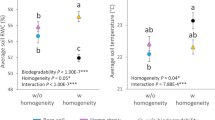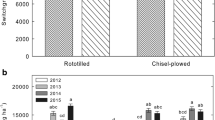Abstract
Weed control is fundamental in plantations of valuable broadleaved species. The most common weeding techniques are repeatedly applied herbicides and removable plastic mulching, both raising environmental concerns. We studied the performance of these techniques on a hybrid walnut plantation, compared with three biodegradable mulch alternatives: a prototype bioplastic film, a layer of composted woodchips and a layer of ramial chips. The durability and effect of the treatments on tree performance (survival, growth, physiological traits) and soil features (moisture and temperature) were evaluated over 4 years. Herbicide yielded the best results, while all the mulching treatments provided better results than controls for nearly all the variables. The performance of plastic and bioplastic films was similar, suggesting that the latter could replace plastic mulching. The performance of the two chip mulches was similar and slightly below that of the films, probably because of the excessive thickness of the former (13–14 cm). In summary, biodegradable mulches showed high effectiveness in controlling weeds and so could offer an alternative to herbicide application and plastic mulching when these are contra-indicated technically (accessibility, repeatability), economically (labour cost), legally or environmentally.



Similar content being viewed by others
References
Abouziena HF, Hafez OM, El-Metwally IM, Sharma SD, Singh M (2008) Comparison of weed suppression and mandarin fruit yield and quality obtained with organic mulches, synthetic mulches, cultivation, and glyphosate. Hort Sci 43(3):795–799
Aletà N, Ninot A, Voltas J (2003) Caracterización del comportamiento agroforestal de doce genotipos de nogal (Juglans sp.) en dos localidades de Cataluña. For Syst 12(1):39–50
Álvarez-Chávez CR, Edwards S, Moure-Eraso R, Geiser K (2012) Sustainability of bio-based plastics: general comparative analysis and recommendations for improvement. J Clean Prod 23:47–56
Ammer C, Balandier P, Scott-Bentsen N, Coll L, Löf M (2011) Forest vegetation management under debate: an introduction. Eur J For Res 130:1–5
Arentoft BW, Ali A, Streibig JC, Andreasen C (2013) A new method to evaluate the weed-suppressing effect of mulches: a comparison between spruce bark and cocoa husk mulches. Weed Res 53(3):169–175
Barajas-Guzmán MG, Barradas VL (2011) Microclimate and sapling survival under organic and polyethylene mulch in a tropical dry deciduous forest. Bol Soc Bot Méx 88:27–34
Barajas-Guzmán MG, Campo J, Barradas VL (2006) Soil water, nutrient availability and sapling survival under organic and polyethylene mulch in a seasonally dry tropical forest. Plant Soil 287(1–2):347–357
Bond B, Grundy AC (2001) Non-chemical weed management in organic farming systems. Weed Res 41:383–405
Ceacero CJ, Díaz-Hernández JL, del Campo AD, Navarro-Cerrillo RM (2012) Evaluación temprana de técnicas de restauración forestal mediante fluorescencia de la clorofila y diagnóstico de vitalidad de brinzales de encina (Quercus ilex sub. ballota). Bosque 33(2):191–202
Chaar H, Mechergui T, Khouaja A, Abid H (2008) Effects of treeshelters and polyethylene mulch sheets on survival and growth of cork oak (Quercus suber L.) seedlings planted in northwestern Tunisia. For Ecol Manage 256:722–731
Chalker-Scott L (2007) Impact of mulches on landscape plants and the environment—a review. J Environ Hort 25(4):239–249
Coello J, Piqué M (2016) Soil conditioners and groundcovers for sustainable and cost-efficient tree planting in Europe and the Mediterranean. Centre Tecnològic Forestal de Catalunya
Coello J, Piqué M, Vericat P (2009) Producció de fusta de qualitat: plantacions de noguera i cirerer: aproximació a les condicions catalanes - guia pràctica. Generalitat de Catalunya, Departament de Medi Ambient i Habitatge, Centre de la Propietat Forestal
Coll L, Balandier P, Picon-Cochard C, Prévosto B, Curt T (2003) Competition for water between beech seedlings and surrounding vegetation in different light and vegetation composition conditions. Ann For Sci 60:593–600
Coll L, Messier C, Delagrange S, Berninger F (2007) Growth, allocation and leaf gas exchanges of hybrid poplar plants in their establishment phase on previously forested sites: effect of different vegetation management techniques. Ann For Sci 64:275–285
Cregg BM, Nzokou P, Goldy R (2009) Growth and physiology of newly planted Fraser fir (Abies fraseri) and Colorado blue spruce (Picea pungens) Christmas trees in response to mulch and irrigation. Hort Sci 44(3):660–665
Devine WD, Harrington CA, Leonard LP (2007) Post-planting treatments increase growth of Oregon white oak (Quercus garryana Dougl. Ex Hook) Seedlings. Restor Ecol 15(2):212–222
Díaz-Pérez JC, Batal KD (2002) Coloured plastic film mulches affect tomato growth and yield via changes in root-zone temperature. J Am Soc Hort Sci 127(1):127–135
Díaz-Pérez JC, Phatak SC, Giddings D, Bertrand D, Mills HA (2005) Root zone temperature, plant growth, and fruit yield of tomatillo as affected by plastic film mulch. Hort Sci 40(5):1312–1319
Djumaeva D, Lamers JPA, Martius C, Vlek PLG (2012) Chlorophyll meters for monitoring foliar nitrogen in three tree species from arid Central Asia. J Arid Environ 85:41–45
Dodd IC, He J, Turnbull CGN, Lee SK, Critchley C (2000) The influence of supra-optimal root-zone temperatures on growth and stomatal conductance in Capsicum annuum L. J Expt Bot 51:239–248
Dumroese RK, Williams MI, Stanturf JA, St. Clair JB (2015) Considerations for restoring temperate forests of tomorrow: forest restoration, assisted migration, and bioengineering. New For 46:947–964
Finkenstadt VL, Tisserat B (2010) Poly(lactic acid) and Osage Orange wood fiber composites for agricultural mulch films. Ind Crops Prod 31(2):316–320
Garlotta D (2001) A literature review of poly(lactic acid). J Polym Environ 9:63–84
George BH, Brennan PD (2002) Herbicides are more cost-effective than alternative weed control methods for increasing early growth of Eucalyptus dunnii and Eucalyptus saligna. New For 24:147–163
Gilman EF, Grabosky J (2004) Mulch and planting depth affect live oak establishment. J Arboricult 30(5):311–317
Granatstein D, Mullinix K (2008) Mulching options for northwest organic and conventional orchards. Hort Sci 43(1):45–50
Green DS, Kruger EL, Stanosz GR (2003) Effects of polyethylene mulch in a short-rotation, poplar plantation vary with weed-control strategies, site quality and clone. For Ecol Manage 173:251–260
Haywood JD (2000) Mulch and hexazinone herbicide shorten the time longleaf pine seedlings are in the grass stage and increase height growth. New For 19(3):279–290
Iles A, Martin AN (2012) Expanding bioplastics production: sustainable business innovation in the chemical industry. J Clean Prod 45:38–49
Jacobs DF, Salifu KF, Seifert JR (2005) Growth and nutritional response of hardwood seedlings to controlled-release fertilization at outplanting. For Ecol Manage 214:28–39
Johansson K, Orlander G, Nilsson U (2006) Effects of mulching and insecticides on establishment and growth of Norway spruce. Can J For Res 36:2377–2385
Kilmartin RF, Peterson JR (1972) Rainfall–runoff regression with logarithmic transforms and zeros in the data. Water Resour Res 8(4):1096–1099
Kogan M, Alister C (2010) Glyphosate use in forest plantations. Chil J Agric Res 70(4):652–666
Kumar S, Dey P (2010) Effects of different mulches and irrigation methods on root growth, nutrient uptake, water-use efficiency and yield of strawberry. Sci Hort 127:318–324
Löf M, Dey DC, Navarro RM, Jacobs DF (2012) Mechanical site preparation for forest restoration. New For 43:825–848
Maggard AO, Will RE, Hennessey TC, McKinley CR, Cole JC (2012) Tree-based mulches influence soil properties and plant growth. Hort Technol 22(3):353–361
Martín-Vide J (1992) El Clima. Geografia General dels Països Catalans. Enciclopèdia Catalana, Barcelona
McConkey T, Bulmer C, Sanborn P (2012) Effectiveness of five soil reclamation and reforestation techniques on oil and gas well sites in northeastern British Columbia. Can J Soil Sci 92(1):165–177
Merwin IA, Hopkins MA, Byard RR (2001) Groundcover management influences nitrogen release, retention, and recycling in a New York apple orchard. Hort Sci 36(3):451
Ninyerola M, Pons X, Roure JM (2005) Atlas Climático Digital de la Península Ibérica. Metodología y aplicaciones en bioclimatología y geobotánica. Universidad Autónoma de Barcelona, Bellaterra
Oliet J, Puértolas J, Planelles R, Jacobs D (2013) Nutrient loading of forest tree seedlings to promote stress resistance and field performance: a Mediterranean perspective. New For 44(5):649–669
Olivera A, Bonet JA, Palacio L, Liu B, Colinas C (2014) Weed control modifies Tuber melanosporum mycelial expansion in young oak plantations. Ann For Sci 71(4):495–504
Pedlar JH, McKenney DW, Fraleigh S (2006) Planting black walnut in southern Ontario: midrotation assessment of growth, yield, and silvicultural treatments. Can J For Res 36(2):495–504
Percival GC, Gklavakis E, Noviss K (2009) The influence of pure mulches on survival, growth and vitality of containerised and field planted trees. J Environ Hort 27(4):200–206
Schott KM, Snively AEK, Landhäusser SM, Pinno BD (2016) Nutrient loaded seedlings reduce the need for field fertilization and vegetation management on boreal forest reclamation sites. New For 47(3):393–410
Shogren RL, Rousseau RJ (2005) Field testing of paper/polymerized vegetable oil mulches for enhancing growth of eastern cottonwood trees for pulp. For Ecol Manage 208:115–122
Solomakhin AA, Trunov YV, Blanke M, Noga G (2012) Organic mulch in apple tree rows as an alternative to herbicide and to improve fruit quality. Acta Hortic 933:513–522
Thakur A, Singh H, Jawandha SK, Kaur T (2012) Mulching and herbicides in peach: weed biomass, fruit yield, size, and quality. Biol Agric Hortic 28(4):280–290
Thiffault N, Roy V (2011) Living without herbicides in Quebec (Canada): historical context, current strategy, research and challenges in forest vegetation management. Eur J For Res 130(1):117–133
Uscola M, Salifu KF, Oliet JA, Jacobs DF (2015) An exponential fertilization dose response model to promote restoration of the Mediterranean oak Quercus ilex. New For 46:795–812
Vallejo RV, Smanis A, Chirino E, Fuentes D, Valdecantos A, Vilagrosa A (2012) Perspectives in dryland restoration: approaches for climate change adaptation. New For 43:561–579
Van Sambeek JW (2010) Database for estimating tree responses of walnut and other hardwoods to ground cover management practices. In: McNeil DL (ed), VI International Walnut Symposium
Van Sambeek JW, Garrett HE (2004) Ground cover management in walnut and other hardwood plantings. In: Michler CH, Pijut PM, Van Sambeek JW, Coggeshall MV, Seifert J, Woeste K, Overton R, Ponder F Jr. (eds) Proceedings of the 6th Walnut Council Research Symposium. U.S. Department of Agriculture, Forest Service, North Central Research Station. St. Paul
Villar-Salvador P, Puértolas J, Cuesta B, Peñuelas JL, Uscola M, Heredia-Guerrero N, Rey Benayas JM (2012) Increase in size and nitrogen concentration enhances seedling survival in Mediterranean plantations. Insights from an ecophysiological conceptual model of plant survival. New For 43(5–6):755–770
Watson WT (2005) Influence of tree size on transplant establishment and growth. Hort Technol 15(1):118–122
Willoughby I, Balandier P, Bentsen NS, McCarthy N, Claridge J (eds) (2009) Forest vegetation management in Europe: current practice and future requirements. COST Off, Brussels
Zegada-Lizarazu W, Berliner PR (2011) The effects of the degree of soil cover with an impervious sheet on the establishment of tree seedlings in an arid environment. New For 42(1):1–17
Zhang S, Lovdahl L, Grip H, Tong Y, Yong X, Wang Q (2009) Effects of mulching and catch cropping on soil temperature, soil moisture and wheat yield on Loess Plateau of China. Soil Tillage Res 102:78–86
Acknowledgements
The experimental design was prepared in collaboration with Philippe Van Lerberghe (IDF-Midi-Pyrénées, France) and Eric Le Boulengé (UCL, Belgium). The authors thank Guillem Martí, Eduard Mauri, Sílvia Busquet, Carla Fuentes, Miquel Sala, Fernando Valencia, Rosalía Domínguez, Sónia Navarro, Àngel Cunill, Alejandro Borque, Sergio Martínez, Toni Gómez and Aleix Guillén for indispensable support during field trial design and/or data collection, Aitor Améztegui for support on data analysis and Terrezu SL and Groencreatie BVBA for providing the prototype biofilm for the trial.
Funding
This work was supported by project Poctefa 93/08 PIRINOBLE: Valuable broadleaves for restoring and enhancing economic development of rural areas: innovation and technology transfer on sustainable plantation techniques.
Author information
Authors and Affiliations
Corresponding author
Rights and permissions
About this article
Cite this article
Coello, J., Coll, L. & Piqué, M. Can bioplastic or woodchip groundcover replace herbicides or plastic mulching for valuable broadleaf plantations in Mediterranean areas?. New Forests 48, 415–429 (2017). https://doi.org/10.1007/s11056-017-9567-7
Received:
Accepted:
Published:
Issue Date:
DOI: https://doi.org/10.1007/s11056-017-9567-7




